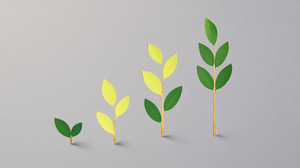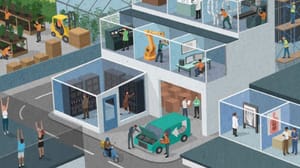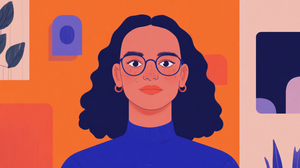Searching for a new design role takes more than luck—it requires preparation, confidence, and a clear strategy. This article offers tips to help you present your best self and navigate the challenges of interviewing. Even if you’re not actively job hunting, these insights will help you stay ready for when the right opportunity comes along.
Preparing for sudden changes
It’s wonderful to be in a job you love—feeling fulfilled and challenged by your work is a great place to be. While you enjoy this moment, it’s also wise to keep an eye on the future. Career paths are rarely linear, and unexpected changes can happen to anyone. Sudden layoffs or restructures might require you to start job hunting without much notice.
The best time to prepare for a job search is before you need one.
Keeping your portfolio and resume current, even when you’re not actively job hunting, is always a good practice. Equally important is staying engaged with your professional network and with what’s going on in the industry. This way, if things change unexpectedly, you’ll be ready to pivot, take action, and make your next move without scrambling to start from scratch.
In times of uncertainty, resilience and preparedness are your greatest assets. More than just bouncing back, resilience helps you adapt to whatever comes your way. Here are some simple practices to help you stay resilient and ready:
- Keep your portfolio and resume current: Regularly update your website and resume with new projects, skills, or accomplishments to reflect your latest work.
- Reflect on your growth: Regularly assess your skills, identify areas for improvement, and set goals to keep advancing.
- Practice storytelling: Get comfortable giving presentations and revisit your case studies, thinking about how you would explain your work.
With practical preparation covered, let’s focus on emotional readiness for job searching.
Prepare yourself emotionally
Job searching can be challenging, especially during uncertain times, but emotional preparation can make a difference. Sudden layoffs can be overwhelming, but they also offer a chance to reset and refocus. The journey may be tough, and the job market competitive, but opportunities are still out there. The key is to stay adaptable, resilient, and ready for whatever comes your way.
Rejection is part of the journey—sometimes, you’ll go through multiple interviews without any feedback. Set realistic expectations, and treat each step as a learning experience. Finding the right role takes time, but every “no” is progress that brings you closer to the right “yes.” Stay focused, keep moving forward, and see each setback as a chance to refine your approach.
Once you have the right mindset, it’s time to craft a personal brand that makes you stand out.
Craft a strong personal brand
How you present yourself really matters. Personal branding is your opportunity to show who you are, what you stand for, and the unique value you bring to the table. If you haven’t thought much about your branding, now is the time.
Treat marketing yourself as a design project. Your resume, website, and case studies deserve the same level of attention to detail that you would give any client project. Refine your brand as an evolving project that represents your best self.
Think about your message. How do you want to talk about yourself? What are your strengths, skills, and core values? Your personal brand should convey all of this clearly and consistently across your portfolio, resume, and LinkedIn profile.
Make sure everything—your website, resume, case studies, and professional profiles—is consistent and aligned in tone, design, and content. If your portfolio follows a bold and minimal design language, ensure your resume and LinkedIn reflect that same style. Consistent visuals and messaging help employers understand you at a glance.
If you don’t have a website yet or feel like yours could use an upgrade, you don’t need to start from scratch. Platforms like Framer offer templates that make it easy to quickly create a polished, professional site. This investment is worth making—a strong online presence can set you apart in the crowded job market.
Once your personal branding is solid, the next step is learning how to align yourself with what specific employers are looking for.
Analyze job descriptions for insights
Pay close attention to how employers talk about their open positions. Job descriptions are full of valuable insights into what companies need and value, and they can guide how you position yourself in your application.
Take a look at this sample job description:
Design is incredibly important to us, and we consider it our competitive advantage. As a Product Designer on the team, you’ll be at the forefront of driving our product forward and realizing our vision. Through beautiful and thoughtful design, and through elegant solutions to complex problems, you’ll make a big impact to the way businesses grow and communicate with their customers every day.
What does this tell us? This company sees design as a core strength and a competitive edge. They’re looking for someone proactive who can align with their ambitious vision. They use phrases like “beautiful and thoughtful design” and “elegant solutions to complex problems,” which means they value aesthetics and functional effectiveness. The role promises meaningful impact, which means they want someone who can make a real difference for their users.
How can you use this information to position yourself?
- Highlight relevant projects: Make sure you showcase work that aligns with the company’s emphasis on beautiful, impactful design.
- Emphasize strategic impact: Show how your work has driven tangible outcomes. Whether improving user experience, solving challenging problems, or delivering measurable results, these details matter.
- Consider your language: Incorporate the company’s values naturally rather than simply repeating their words. For instance, if they value “impactful design,” demonstrate how your past projects created meaningful impact for the business or customer. Ensure your portfolio reflects both aesthetic quality and strategic depth.
Once you understand employer needs, you should focus on how your skills and experiences can benefit the company and the role.
Show how you can benefit the company
You’ll likely get questions like, “Why do you want this role?” or “Why do you want to work for this company?” It’s easy to fall into the trap of talking about what excites you personally or how the role will help you grow. While those points are valid, remember that employers want to know how you will help them.
This doesn’t mean you can’t talk about what interests you—just don’t lead with it. Focus on how your skills, experience, and values align with the company’s goals. Highlight relevant experiences that address their specific challenges, and tailor your cover letter or application to each job. Show how your background supports their objectives and why you’re uniquely suited to help them succeed.
Employers feel reassured when you demonstrate how your skills fit their needs and how you’ve tackled similar challenges. When you address how your experience aligns with their expectations, you show both preparation and commitment.
Be ready to answer, “Why do you want to work for this company?” A good answer requires research—look into the company’s history, how it started, who the founders are, their story, its culture, and what customers say about it. This kind of knowledge helps you deliver a personalized response that shows you’ve taken the time to understand them. The goal is to find an authentic connection to the company.
Example answer
“I’m genuinely drawn to this role because your company’s story resonates with me. I admire how the founders started with a vision to solve [specific problem] and how that vision has evolved to create meaningful solutions that empower your customers. My experience transforming complex challenges into elegant, user-centric solutions aligns perfectly with the impact your company strives to achieve. I’ve worked on projects where thoughtful design was the key to bridging gaps in communication, much like your focus on helping businesses connect more deeply with their customers. I’m eager to bring my skills in [specific relevant experience] to your team and be a part of this journey, impacting your clients and the industry.”
This response shows that you’ve done your homework, connects your personal experience to their needs, and conveys enthusiasm for the role—all while keeping the company’s priorities at the center.
To truly stand out, you also need to effectively showcase your problem-solving abilities through compelling case studies.
Develop impactful case studies
You don’t want to realize the importance of preparation after the interview is over. Knowing how you will present yourself, your skills, and your work is crucial—and the best way to prepare is to write it all out. Writing out your thoughts helps you clarify your ideas, and once you’ve done this thoroughly, you can refine your presentation for each interview.
Case studies are a vital part of this preparation. These aren’t just the case studies on your website—these are the stories you bring to life during interviews. This is your opportunity to make a lasting impact. Presenting with confidence helps convey your message clearly and instills confidence in others about your abilities. Remember, part of your success is about optics—people may not remember every detail, but they will remember how you made them feel and the impression you left. Your goal is to spark genuine interest and leave a memorable mark.
Typically, two well-prepared case studies are enough for most interviews.
Spend time crafting these case studies—they’re about telling a story. Focus on showing your process, how you collaborate, and how you navigate challenges. Make them personal by looking for the “story gems” that add color to your narrative. Maybe it was a breakthrough moment, an impactful conversation with a product manager, or a piece of customer feedback that changed your approach. The design process is rarely linear, so share the real moments that made the project come to life.
To truly convey impact, close each case study by emphasizing the key metrics or business outcomes your work directly influenced. Highlight these results clearly, as they provide concrete evidence of your contributions. Quantifiable outcomes like increased customer retention, reduced support tickets, or a boost in sales are powerful indicators of the value you bring as a designer. You’ll leave a strong, lasting impression by ending with the results that improved the product experience and helped the business.
Think of your case studies as design projects themselves. Every detail you show reflects your taste, style, and commitment to quality. Invest the effort into designing your slides, polishing your story, and ensuring each detail contributes to the overall narrative. Embrace the process—this is your chance to show off your design thinking and storytelling skills.
Landing your dream design role takes effort, but it's within reach with the right mindset and preparation. Build resilience, refine your personal brand, and align your skills with each employer’s needs. Treat every interview as a chance to learn, and view setbacks as steps toward the right fit.
Trust in your ability to make an impact, stay determined, and keep moving forward—the right opportunity is waiting.





